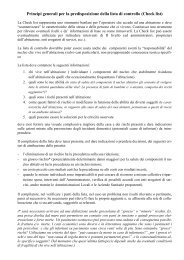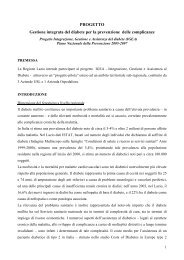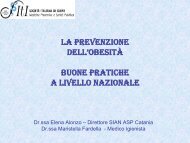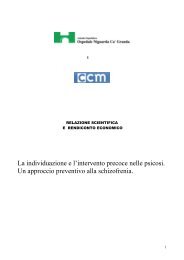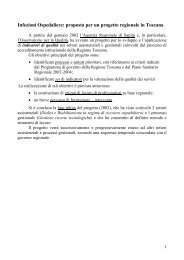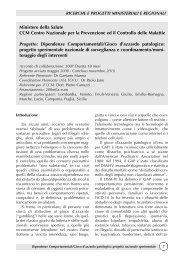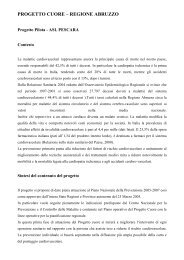Gaining health : analysis of policy development in European ...
Gaining health : analysis of policy development in European ...
Gaining health : analysis of policy development in European ...
You also want an ePaper? Increase the reach of your titles
YUMPU automatically turns print PDFs into web optimized ePapers that Google loves.
2.6. Sett<strong>in</strong>gs<br />
S<strong>in</strong>ce the mid-1990s, the sett<strong>in</strong>gs focus has been strengthened<br />
by <strong>in</strong>volvement <strong>in</strong> <strong>in</strong>ternational networks such as<br />
Health Promot<strong>in</strong>g Schools, Healthy Cities and Health Promot<strong>in</strong>g<br />
Hospitals, all <strong>of</strong> which cont<strong>in</strong>ue to grow.<br />
2.6.1. Schools<br />
Ireland jo<strong>in</strong>ed the ENHPS <strong>in</strong> 1992. From 1993 to 1996<br />
there were 10 schools <strong>in</strong> the Irish network (5 primary and<br />
5 post-primary). From 1996 to 1999 the network expanded<br />
to <strong>in</strong>clude 40 schools (20 primary and 20 post-primary). For<br />
schools <strong>in</strong> general, <strong>health</strong> education was an optional subject<br />
until that time, develop<strong>in</strong>g <strong>in</strong> different ways throughout the<br />
country.<br />
It was decided <strong>in</strong> 1999 that specific support would discont<strong>in</strong>ue<br />
for a designated network <strong>of</strong> schools and that <strong>in</strong>stead<br />
all schools would be supported. Consequently, when<br />
“social, personal and <strong>health</strong> education” (SPHE) became a<br />
required part <strong>of</strong> the curriculum for all primary and postprimary<br />
schools <strong>in</strong> 2000, it was decided to subsume the<br />
experience <strong>of</strong> the Health Promot<strong>in</strong>g Schools network with<br />
a substance abuse prevention programme that had been<br />
used <strong>in</strong> some schools s<strong>in</strong>ce 1991; a relationships and sexuality<br />
education programme (first developed <strong>in</strong> 1995); and<br />
a life-skills (<strong>health</strong> education) programme that had been<br />
operat<strong>in</strong>g <strong>in</strong> many schools <strong>in</strong> one local region s<strong>in</strong>ce 1979.<br />
All these were <strong>in</strong>cluded under the new SPHE umbrella, and<br />
schools are supported to implement SPHE “<strong>in</strong> a <strong>health</strong> promot<strong>in</strong>g<br />
school context”. Sub-networks <strong>of</strong> schools cont<strong>in</strong>ue<br />
to operate <strong>in</strong> three regions <strong>of</strong> the country, us<strong>in</strong>g the ENHPS<br />
process, but are not l<strong>in</strong>ked to each other or to a national<br />
network.<br />
In 2005, the National Taskforce on Obesity identified<br />
300 000 Irish children as be<strong>in</strong>g overweight or obese, a<br />
figure that was <strong>in</strong>creas<strong>in</strong>g by 10 000 each year, and made<br />
recommendations for support<strong>in</strong>g schools. Accord<strong>in</strong>g to a<br />
survey published by the Irish Heart Foundation <strong>in</strong> 2007<br />
(38), only one third <strong>of</strong> schools had developed <strong>health</strong>y eat<strong>in</strong>g<br />
policies. Energy-dense and nutrient-poor foods are widely<br />
available <strong>in</strong> tuck shops and vend<strong>in</strong>g mach<strong>in</strong>es. Schools, many<br />
<strong>of</strong> which rely on commercial sponsorship for sports and<br />
computer equipment, reported overwhelm<strong>in</strong>gly that they<br />
would be <strong>in</strong> favour <strong>of</strong> a code <strong>of</strong> practice <strong>in</strong> relation to the<br />
provision and content <strong>of</strong> vend<strong>in</strong>g mach<strong>in</strong>es (92%), and a <strong>of</strong><br />
national code <strong>of</strong> practice <strong>in</strong> relation to <strong>in</strong>dustrial sponsorship<br />
(87%).<br />
On a more general level <strong>in</strong> the education sector, goals <strong>in</strong><br />
relation to school retention and address<strong>in</strong>g literacy difficulties<br />
are acknowledged as enhanc<strong>in</strong>g personal skills, affect<strong>in</strong>g<br />
<strong>health</strong> <strong>in</strong> the long-term.<br />
2.6.2. The workplace<br />
An all-island (Ireland and Northern Ireland) network for<br />
workplace <strong>health</strong> promotion was established and all the<br />
then regional <strong>health</strong> boards had workplace coord<strong>in</strong>ators.<br />
The Health Promotion Unit participates <strong>in</strong> the correspond<strong>in</strong>g<br />
<strong>European</strong> network <strong>of</strong> national agencies and <strong>in</strong>stitutes<br />
with responsibility for <strong>health</strong> <strong>in</strong> the workplace. The <strong>policy</strong><br />
document Healthy bodies – <strong>health</strong>y work (39), published <strong>in</strong><br />
1999, outl<strong>in</strong>ed the need for a proactive approach <strong>in</strong> the<br />
workplace. The implementation <strong>of</strong> cardiovascular strategies<br />
is one <strong>of</strong> the priorities for the workplace sett<strong>in</strong>g. Some<br />
650 companies with 350 000 employees participate <strong>in</strong> the<br />
“Happy heart at work” <strong>in</strong>itiative.<br />
2.7. Policies for specific population groups – older<br />
people<br />
There are a number <strong>of</strong> policies directed at specific population<br />
groups relevant to combat<strong>in</strong>g NCD, <strong>in</strong>clud<strong>in</strong>g a <strong>policy</strong><br />
for men’s <strong>health</strong> – there is a gap <strong>of</strong> 15 years between the<br />
average life expectancy <strong>of</strong> a rich woman and a poor man. In<br />
the framework <strong>of</strong> this study, we refer only to <strong>policy</strong> related<br />
to older people.<br />
Chapter 4<br />
165<br />
Case studies: <strong>policy</strong> <strong>development</strong> <strong>in</strong> countries for tackl<strong>in</strong>g noncommunicable diseases



